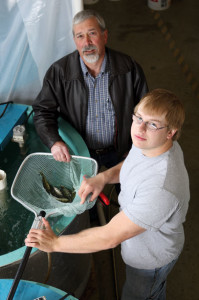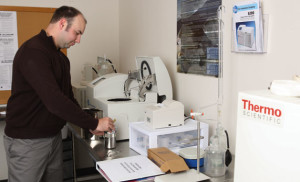
Professor Michael Brown, of the natural resource management department, and Tabor Martin, a wildlife and fisheries major from Canton, examine the condition of yellow perch being fed test diets containing experimental soy protein.
Soybean meal may make fish farming sustainable
Nearly 1 billion people rely on fish as their primary source of animal protein, yet an estimated 30 percent of the world’s fish populations have become overexploited and 57 percent are fully exploited.
Commercial fish farms have begun to fill the gap, but they also rely on fish meal made from small marine species, such as menhaden, anchoveta, herring and sardines as the protein source for commercial fish feed. An estimated 70 percent of the wild fish captured in 2011 were used for aquaculture production, according to United Nations statistics.
“It’s a perfect storm of natural resources dropping and demand increasing for replacement products,†says professor William Gibbons of the biology and microbiology department.
To solve this problem, Gibbons and professor Michael Brown of the natural resource management department have developed a method of converting soybean meal into a concentrated soy protein ingredient that can replace marine-derived protein in commercial fish feed.
The researchers predict that this will decrease the cost of high quality fish feed, expand opportunities for South Dakota products and make commercial fish production more profitable.
The three-year project, which began in 2011, has received about $1.7 million from the South Dakota Soybean Research and Promotion Council, with funds coming from the checkoff system. In addition, the researchers have received support from the Agricultural Experiment Station and funding for equipment through the South Dakota Board of Regents and the Legislature.
Fish feed accounts for 50 to 70 percent of fish farmers’ production costs, according to the United Nations’ Food and Agriculture Organization. Using expensive fish meal as a major feed component drives up the cost of production, Brown says.
It’s a team effort. Gibbons transforms the soybean meal into a form that the fish can use. Brown then determines the percentage of soy product that can be used to replace the marine-derived protein yet maintain a nutritionally balanced diet for the fish.
Making soy meal more digestible
“When you look at the composition of soy compared to cereal grains and other oilseeds, it most closely mirrors that of marine-derived protein,†Gibbons says. However, the soy meal must first be processed to boost its protein content and minimize what he calls “anti-nutritional components.â€
Gibbons and his team treat the soy meal to mechanically and chemically open up the fibrous material and then add enzymes and microorganisms that transform the complex sugars into proteins. Four undergraduate students and one postdoctoral researcher work on this project.

Doctoral student Timothy Bruce uses a calorimeter to determine total energy content of an experimental soy-based fish feed. Bruce came to SDSU after completing his master’s degree at Purdue.
“It is possible that the process results in a probiotic effect on the immune system of fish like yogurt is to humans,†Gibbons says, making the nutrients easier to absorb. The conversion process increases the protein content from about 45 percent to about 70 percent.
When the incubation process is complete, the solids are harvested, dried and then delivered to Brown in sufficient quantities for formulation and feed production.
Formulating and testing the feed
Brown determines the composition of the experimental soy products and formulates blends to meet the nutritional requirements in terms of protein, amino acids, vitamins and minerals for a particular fish species.
Brown and his team assess product digestibility and then formulate a series of diets using varying levels of soy protein to replace fish meal. These diets are then fed to yellow perch and rainbow trout to determine the effects on efficiencies and growth performance. Three doctoral students, two master’s students and five undergraduates work on this project.
In addition, Bell Aquaculture, a commercial fish farm in Red Key, Ind., is testing a first-generation, converted soy protein to replace fish meal using its own feed formulations. This will provide independent validation of the soy protein, Brown explains.
With modified soybean meal, he believes he may be able to replace most, if not all, of the marine-based protein in feeds produced for the two fish species being testing.
That’s encouraging news for Doug Hanson, a member of the South Dakota Soybean Council and one of the driving forces behind this research.
Opening new markets
“The U.S. is a small player in aquaculture,†Hanson says, citing China as the industry leader. “We decided to see what we can do domestically with research to be competitive in producing fish.â€
Raising fish commercially is more than just pond feeding, Hanson explains. “It’s moved indoors just like the chicken, pork and turkey industries, and we should be able to raise fish intensively as well as anyone else.â€
Based on conversations with local businessmen, Hanson says, “we just need to show that it’s profitable for investors to look at it seriously.â€
Last year the Elk Point farmer planted 20 acres of soybeans bred specifically for commercial fish feed. According to Brown, these beans are high in protein and low in sugars and oil. Despite the challenging growing season, Hanson says the yield was about the same as his other soybean varieties.
Brown estimates that about a dozen small fish production facilities producing anywhere from 5,000 to 400,000 pounds of fish per year operate in South Dakota. “These fish farms get feed from as far away as Louisiana and Utah,†he says.
Through the assistance of South Dakota Innovation Partners, the two researchers have formed Prairie AquaTech, which has lab space in the city-owned Brookings Research and Technology Center on 32nd Avenue. This is where the lab-scale feeding trials are conducted.
When the new Ag Technology Center is completed, the company will be able to start pilot-scale production of ingredients and larger fish performance trials. Brown will also be able to include salmon and tilapia in his feeding trials. Construction on the 30,000-square-foot technology commercialization center in the city’s east side industrial park is expected to begin this summer.
On April 18, the cost of raw soybean meal was $419 per ton, according to Tom Kersting, CEO of the South Dakota Soybean Processors. Every 60 pounds of soybeans produces 44 pounds of soybean meal, for a total output of around 600,000 tons of meal per year at the Volga plant alone.
Even if processing of the soy doubles the cost of the feed, it will result in a 50 percent savings for commercial fish producers, explains Gibbons. “We can create a new local product that will be twice as valuable.â€
Most of the Volga plant’s soybean meal goes to feed swine with a lesser amount used for poultry, explains Kersting. “This would help expand our market base with a new type of livestock.â€
As a result of this work, South Dakota soybean growers and processors can have a hand in feeding the world’s population and in making commercial fish farming a sustainable industry.
Christie Delfanian






